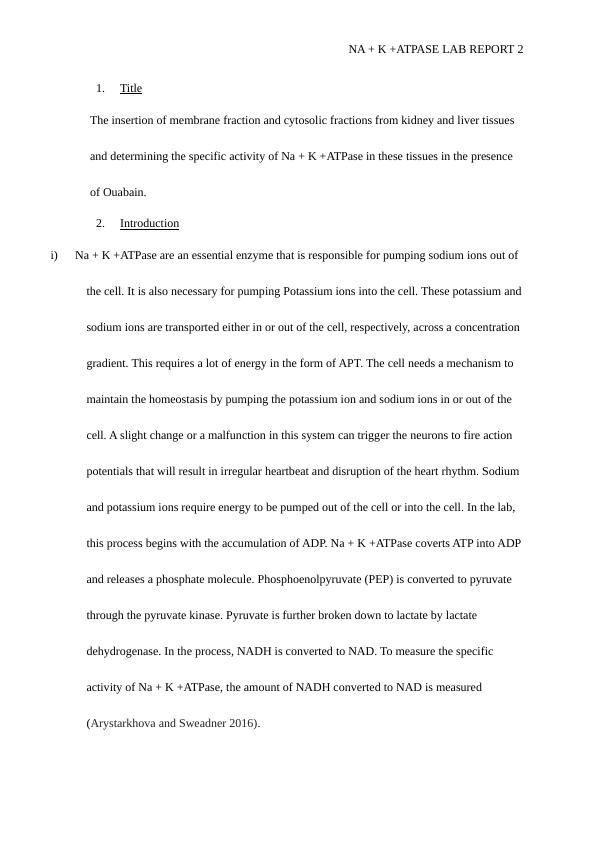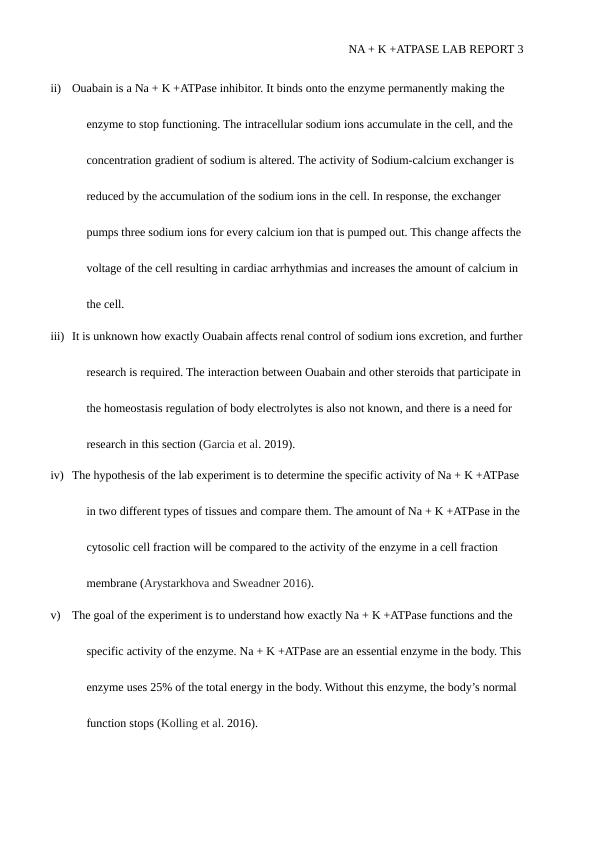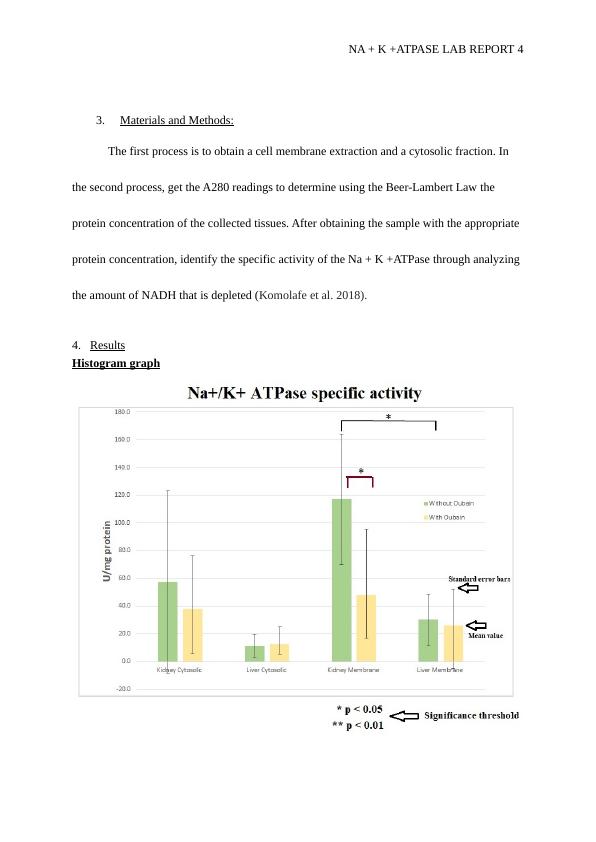NA + K +ATPASE Lab Report
Added on 2023-03-30
14 Pages2654 Words410 Views
NA + K +ATPASE LAB REPORT 1
NA + K +ATPASE LAB REPORT
By (Name)
The Name of the Class (Course)
Professor (Tutor)
Name of School (University)
The City and State Where It Is Placed
Date
NA + K +ATPASE LAB REPORT
By (Name)
The Name of the Class (Course)
Professor (Tutor)
Name of School (University)
The City and State Where It Is Placed
Date

NA + K +ATPASE LAB REPORT 2
1. Title
The insertion of membrane fraction and cytosolic fractions from kidney and liver tissues
and determining the specific activity of Na + K +ATPase in these tissues in the presence
of Ouabain.
2. Introduction
i) Na + K +ATPase are an essential enzyme that is responsible for pumping sodium ions out of
the cell. It is also necessary for pumping Potassium ions into the cell. These potassium and
sodium ions are transported either in or out of the cell, respectively, across a concentration
gradient. This requires a lot of energy in the form of APT. The cell needs a mechanism to
maintain the homeostasis by pumping the potassium ion and sodium ions in or out of the
cell. A slight change or a malfunction in this system can trigger the neurons to fire action
potentials that will result in irregular heartbeat and disruption of the heart rhythm. Sodium
and potassium ions require energy to be pumped out of the cell or into the cell. In the lab,
this process begins with the accumulation of ADP. Na + K +ATPase coverts ATP into ADP
and releases a phosphate molecule. Phosphoenolpyruvate (PEP) is converted to pyruvate
through the pyruvate kinase. Pyruvate is further broken down to lactate by lactate
dehydrogenase. In the process, NADH is converted to NAD. To measure the specific
activity of Na + K +ATPase, the amount of NADH converted to NAD is measured
(Arystarkhova and Sweadner 2016).
1. Title
The insertion of membrane fraction and cytosolic fractions from kidney and liver tissues
and determining the specific activity of Na + K +ATPase in these tissues in the presence
of Ouabain.
2. Introduction
i) Na + K +ATPase are an essential enzyme that is responsible for pumping sodium ions out of
the cell. It is also necessary for pumping Potassium ions into the cell. These potassium and
sodium ions are transported either in or out of the cell, respectively, across a concentration
gradient. This requires a lot of energy in the form of APT. The cell needs a mechanism to
maintain the homeostasis by pumping the potassium ion and sodium ions in or out of the
cell. A slight change or a malfunction in this system can trigger the neurons to fire action
potentials that will result in irregular heartbeat and disruption of the heart rhythm. Sodium
and potassium ions require energy to be pumped out of the cell or into the cell. In the lab,
this process begins with the accumulation of ADP. Na + K +ATPase coverts ATP into ADP
and releases a phosphate molecule. Phosphoenolpyruvate (PEP) is converted to pyruvate
through the pyruvate kinase. Pyruvate is further broken down to lactate by lactate
dehydrogenase. In the process, NADH is converted to NAD. To measure the specific
activity of Na + K +ATPase, the amount of NADH converted to NAD is measured
(Arystarkhova and Sweadner 2016).

NA + K +ATPASE LAB REPORT 3
ii) Ouabain is a Na + K +ATPase inhibitor. It binds onto the enzyme permanently making the
enzyme to stop functioning. The intracellular sodium ions accumulate in the cell, and the
concentration gradient of sodium is altered. The activity of Sodium-calcium exchanger is
reduced by the accumulation of the sodium ions in the cell. In response, the exchanger
pumps three sodium ions for every calcium ion that is pumped out. This change affects the
voltage of the cell resulting in cardiac arrhythmias and increases the amount of calcium in
the cell.
iii) It is unknown how exactly Ouabain affects renal control of sodium ions excretion, and further
research is required. The interaction between Ouabain and other steroids that participate in
the homeostasis regulation of body electrolytes is also not known, and there is a need for
research in this section (Garcia et al. 2019).
iv) The hypothesis of the lab experiment is to determine the specific activity of Na + K +ATPase
in two different types of tissues and compare them. The amount of Na + K +ATPase in the
cytosolic cell fraction will be compared to the activity of the enzyme in a cell fraction
membrane (Arystarkhova and Sweadner 2016).
v) The goal of the experiment is to understand how exactly Na + K +ATPase functions and the
specific activity of the enzyme. Na + K +ATPase are an essential enzyme in the body. This
enzyme uses 25% of the total energy in the body. Without this enzyme, the body’s normal
function stops (Kolling et al. 2016).
ii) Ouabain is a Na + K +ATPase inhibitor. It binds onto the enzyme permanently making the
enzyme to stop functioning. The intracellular sodium ions accumulate in the cell, and the
concentration gradient of sodium is altered. The activity of Sodium-calcium exchanger is
reduced by the accumulation of the sodium ions in the cell. In response, the exchanger
pumps three sodium ions for every calcium ion that is pumped out. This change affects the
voltage of the cell resulting in cardiac arrhythmias and increases the amount of calcium in
the cell.
iii) It is unknown how exactly Ouabain affects renal control of sodium ions excretion, and further
research is required. The interaction between Ouabain and other steroids that participate in
the homeostasis regulation of body electrolytes is also not known, and there is a need for
research in this section (Garcia et al. 2019).
iv) The hypothesis of the lab experiment is to determine the specific activity of Na + K +ATPase
in two different types of tissues and compare them. The amount of Na + K +ATPase in the
cytosolic cell fraction will be compared to the activity of the enzyme in a cell fraction
membrane (Arystarkhova and Sweadner 2016).
v) The goal of the experiment is to understand how exactly Na + K +ATPase functions and the
specific activity of the enzyme. Na + K +ATPase are an essential enzyme in the body. This
enzyme uses 25% of the total energy in the body. Without this enzyme, the body’s normal
function stops (Kolling et al. 2016).

NA + K +ATPASE LAB REPORT 4
3. Materials and Methods:
The first process is to obtain a cell membrane extraction and a cytosolic fraction. In
the second process, get the A280 readings to determine using the Beer-Lambert Law the
protein concentration of the collected tissues. After obtaining the sample with the appropriate
protein concentration, identify the specific activity of the Na + K +ATPase through analyzing
the amount of NADH that is depleted (Komolafe et al. 2018).
4. Results
Histogram graph
3. Materials and Methods:
The first process is to obtain a cell membrane extraction and a cytosolic fraction. In
the second process, get the A280 readings to determine using the Beer-Lambert Law the
protein concentration of the collected tissues. After obtaining the sample with the appropriate
protein concentration, identify the specific activity of the Na + K +ATPase through analyzing
the amount of NADH that is depleted (Komolafe et al. 2018).
4. Results
Histogram graph

End of preview
Want to access all the pages? Upload your documents or become a member.
Related Documents
Anatomy and Transport Across Plasma Membranelg...
|4
|644
|419
Na+ Regulation in the Malaria Parasite Plasmodium Falciparumlg...
|10
|2561
|32
